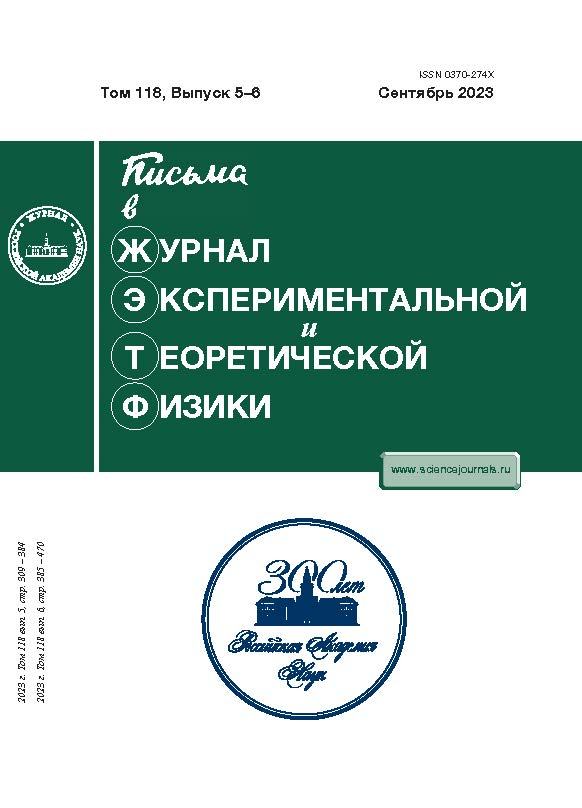Temperature-Induced Transition Between Resistive Switching Modes of Parylene-Based Memristive Crossbar Structures
- 作者: Matsukatova A.N.1,2, Trofimov A.D.1,3, Emel'yanov A.V.1,3
-
隶属关系:
- National Research Center Kurchatov Institute
- Moscow State University
- Moscow Institute of Physics and Technology (National Research University)
- 期: 卷 118, 编号 5-6 (9) (2023)
- 页面: 355-360
- 栏目: Articles
- URL: https://vestnik.nvsu.ru/0370-274X/article/view/663072
- DOI: https://doi.org/10.31857/S1234567823170081
- EDN: https://elibrary.ru/KAFCDV
- ID: 663072
如何引用文章
详细
In order to create neuromorphic computing systems (NCSs) capable of efficiently solving artificial intelligence problems, elements with short- and long-term memory effects are required. Memristors are promising candidates for the implementation of such elements since they demonstrate volatile and nonvolatile resistive switching (RS) modes. Of particular interest are structures that realize both RS modes in a single device. In this work, parylene-based nanocomposite memristors with MoO3 nanoparticles have been studied in crossbar architecture, which is convenient for NCS implementation. For these structures, a reversible temperature-induced transition between volatile and nonvolatile RS modes was found if local, controlled via the compliance current, or external temperature is fine-tuned. In addition, the crossbar structures showed high endurance to cyclic RS, ability to retain states in nonvolatile mode and multilevel nature of RS. The obtained results open the possibility of using parylene-based crossbar structures in bioinspired NCSs.
作者简介
A. Matsukatova
National Research Center Kurchatov Institute;Moscow State University
Email: an.matcukatova@physics.msu.ru
123182, Moscow, Russia;119991, Moscow, Russia
A. Trofimov
National Research Center Kurchatov Institute;Moscow Institute of Physics and Technology (National Research University)
Email: an.matcukatova@physics.msu.ru
123182, Moscow, Russia;141701, Dolgoprudnyi, Moscow region, Russia
A. Emel'yanov
National Research Center Kurchatov Institute;Moscow Institute of Physics and Technology (National Research University)
编辑信件的主要联系方式.
Email: an.matcukatova@physics.msu.ru
123182, Moscow, Russia;141701, Dolgoprudnyi, Moscow region, Russia
参考
- P. A. Merolla, J. V. Arthur, R. Alvarez-Icaza et al. (Collaboration), Science 345, 668 (2014).
- S. Kumar, R. S. Williams, and Z. Wang, Nature 585, 518 (2020).
- Y. Zhang, Z. Wang, J. Zhu, Y. Yang, M. Rao, W. Song, Y. Zhuo, X. Zhang, M. Cui, L. Shen, R. Huang, and J. J. Yang, Appl. Phys. Rev. 7, 011308 (2020).
- L. Yuan, S. Liu, W. Chen, F. Fan, and G. Liu, Adv. Electron. Mater. 7, 2100432 (2021).
- W. Wang, M. Wang, E. Ambrosi, A. Bricalli, M. Laudato, Z. Sun, X. Chen, and D. Ielmini, Nat.Commun. 10, 81 (2019).
- M. D. Pickett, G. Medeiros-Ribeiro, and R. S. Williams, Nat. Mater. 12, 114 (2013).
- A. N. Matsukatova, N. V. Prudnikov, V. A. Kulagin et al. (Collaboration), Adv.Intell. Syst. 5, 2200407 (2023).
- S. Shchanikov, A. Zuev, I. Bordanov, S. Danilin, V. Lukoyanov, D. Korolev, A. Belov, Y. Pigareva, A. Gladkov, A. Pimashkin, A. Mikhaylov, V. Kazantsev, and A. Serb, Chaos, Solitons and Fractals 142, 110504 (2021).
- T. Luibrand, A. Bercher, R. Rocco et al. (Collaboration), Phys. Rev. Research 5, 013108 (2023).
- S. Balatti, S. Larentis, D. C. Gilmer, and D. Ielmini, Adv. Mater. 25, 1474 (2013).
- S. E. Kim, M.-H. Kim, J. Jang, H. Kim, S. Kim, J. Jang, J.-H. Bae, I. M. Kang, and S.-H. Lee, Adv.Intell. Syst. 4, 2200110 (2022).
- H. Sun, Q. Liu, C. Li, S. Long, H. Lv, C. Bi, Z. Huo, L. Li, and M. Liu, Adv. Funct. Mater. 24, 5679 (2014).
- Q. Tian, X. Chen, X. Zhao, Z. Wang, Y. Lin, Y. Tao, H. Xu, and Y. Liu, Appl. Phys. Lett. 122, 153502 (2023).
- A. A. Minnekhanov, B. S. Shvetsov, M. M. Martyshov, K. E. Nikiruy, E. V. Kukueva, M. Yu. Presnyakov, P. A. Forsh, V. V. Rylkov, V. V. Erokhin, V. A. Demin, and A. V. Emelyanov, Org. Electron. 74, 89 (2019).
- A. A. Minnekhanov, A. V. Emelyanov, D. A. Lapkin, K. E. Nikiruy, B. S. Shvetsov, A. A. Nesmelov, V. V. Rylkov, V. A. Demin, and V. V. Erokhin, Sci. Rep. 9, 10800 (2019).
- А. Н. Мацукатова, А. В. Емельянов, А. А. Миннеханов, В. А. Демин, В. В. Рыльков, П. А. Форш, П. К. Кашкаров, Письма в ЖЭТФ 112, 379 (2020).
- W. Banerjee, Q. Liu, and H. Hwang, J. Appl. Phys. 127, 051101 (2020).
- Q. Chen, M. Lin, Z. Wang, X. Zhao, Y. Cai, Q. Liu, Y. Fang, Y. Yang, M. He, and R. Huang, Mater. 5, 1800852 (2019).
- А. Н. Мацукатова, А. В. Емельянов, А. А. Миннеханов, Д. А. Сахарутов, А. Ю. Вдовиченко, Р. А. Камышинский, В. А. Демин, В. В. Рыльков, П. А. Форш, С. Н. Чвалун, П. К. Кашкаров, Письма в журнал технической физики 46, 25 (2020)
- A. N. Matsukatova, A. V. Emelyanov, A. A. Minnekhanov, D. A. Sakharutov, A. Yu. Vdovichenko, R. A. Kamyshinskii, V. A. Demin, V. V. Rylkov, P. A. Forsh, S. N. Chvalun, and P. K. Kashkarov. Tech. Phys. Lett. 46, 73 (2020).
- B. S. Shvetsov, A. A. Minnekhanov, A. V. Emelyanov, A. I. Ilyasov, Y. V. Grishchenko, M. L. Zanaveskin, A. A. Nesmelov, D. R. Streltsov, T. D. Patsaev, A. L. Vasiliev, V. V. Rylkov, and V. A. Demin, Nanotechnology 33, 255201 (2022).
- A. N. Matsukatova, A. Y. Vdovichenko, T. D. Patsaev, P. A. Forsh, P. K. Kashkarov, V. A. Demin, and A. V. Emelyanov, Nano Res. 16, 3207 (2023).
- K. E. Nikiruy, A. V. Emelyanov, V. A. Demin, V. V. Rylkov, A. V. Sitnikov, and P. K. Kashkarov, Tech. Phys. Lett. 44, 416 (2018).
- N. Ge, M.-X. Zhang, L. Zhang, J. J. Yang, Z. Li, and R. S. Williams, Semicond. Sci. Technol. 29, 104003 (2014).
- P. Praveen, T. P. Rose, and K. J. Saji, Microelectronics J. 121, 105388 (2022).
补充文件









